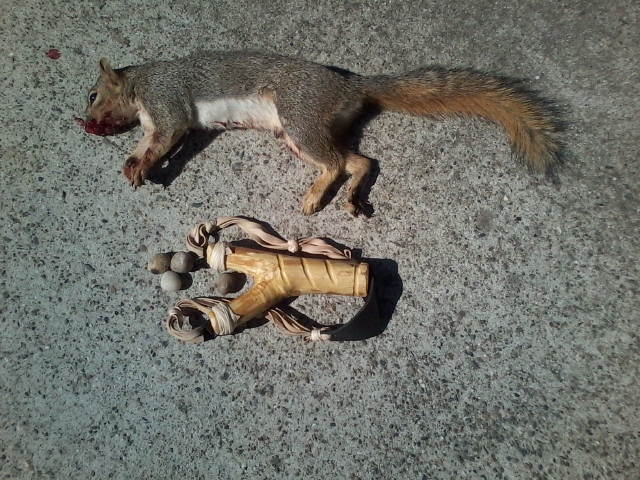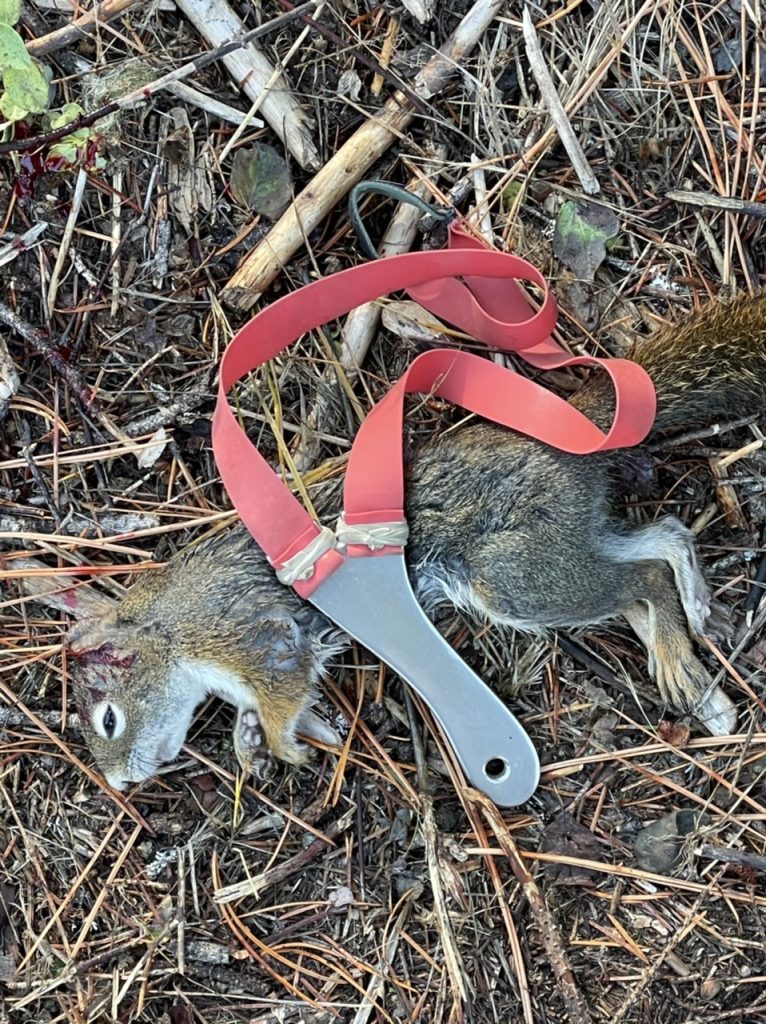Your cart is currently empty!

Guide: How to Hunt Squirrels with a Slingshot Like a Pro!

Table of Contents
Introduction
The allure of hunting, an age-old human practice, has taken many forms over the millennia. One method, which has roots as deep as our ancestors’ earliest endeavors, is the use of slingshots. Today, many hunters are rediscovering the joy and skill required in using this primitive tool, especially when it comes to challenging targets like squirrels. If you’ve ever wondered how to hunt squirrels with a slingshot, you’re tapping into a tradition that stretches back generations. Squirrel hunting with a slingshot isn’t just about aiming and shooting; it’s a dance of patience, understanding, and precision. These agile creatures, with their quick movements and sharp senses, present a rewarding challenge for any hunter. In this guide, we’ll delve deep into the techniques, strategies, and nuances that can turn a novice into a seasoned pro. For those already acquainted with the hunt, there might still be a trick or two you can add to your repertoire. So, whether you’re a beginner seeking guidance on how to hunt squirrels with a slingshot or a veteran looking to refine your skills, this ultimate guide has got you covered.
Choosing the Perfect Slingshot for the Hunt
Venturing into the realm of hunting, especially with a tool as unique as a slingshot, demands precision, patience, and of course, the right equipment. When the target is as agile and nimble as a squirrel, the choice of your slingshot becomes even more crucial. Let’s dive into the intricacies of selecting the perfect slingshot for your squirrel hunting endeavors.
The Importance of the Right Slingshot in Hunting Small Game
Hunting small game is a delicate balance of stealth, aim, and equipment. While the stealth and aim are skills honed over time, your equipment needs to be on point from the get-go. A squirrel, with its rapid movements, requires that your slingshot provides the right amount of power without sacrificing accuracy. Moreover, the ease with which you handle your slingshot will determine how quickly you can react to sudden squirrel movements.
Different Types of Slingshots: Traditional vs. Modern
Historically, slingshots were simple Y-shaped structures with elastic attached. These traditional slingshots were primarily made of wood and had a charm of their own. They were rustic, essential, yet efficient for their time. However, with advancements in technology, modern slingshots have made their way into the hunting scene. Made from materials like high-grade aluminum or steel, these modern marvels are not only durable but also designed for enhanced precision. Many even come with arm braces and sights to improve stability and accuracy.

Features to Look For: Grip, Band Type, Fork Width, and Materials
When shopping for a slingshot, several features can make a significant difference in your hunting experience:
- Grip: A comfortable grip ensures steady shots. Look for ergonomically designed handles that fit well in your hand.
- Band Type: Latex bands are popular for their elasticity and power. Depending on your preference, you can opt for flat bands for a more streamlined shot or tubular bands for a bit more power.
- Fork Width: A wider fork can offer more power but might compromise on accuracy, especially for beginners. A narrower fork can provide better precision but may require more strength to pull.
- Materials: Modern slingshots come in a range of materials. While metal ones offer durability and a solid feel, plastic or composite slingshots can be lighter and easier to handle for prolonged periods.
Personalization and Adjustments for Better Accuracy and Comfort
No two hunters are the same, and neither should their slingshots be. Once you’ve chosen your slingshot, consider personalizing it. Adjust the band’s length to fit your draw length, change the pouch if it doesn’t feel right, or even add sights for improved accuracy. Remember, comfort leads to confidence, and confidence is key when learning how to hunt squirrels with a slingshot.
Mastering the Art of Aiming and Shooting
Slingshot hunting, particularly when your target is as agile as a squirrel, demands more than just the right equipment. It requires a mastery of technique. Hunting these little creatures isn’t about brute force; it’s a refined skill, a delicate blend of stability, precision, and control. Let’s delve into the elements of aiming and shooting that can elevate your hunting prowess.
Proper Stance and Hand Positioning for Increased Stability
Stability is paramount. Before you even draw back your slingshot, your stance will set the foundation for your shot. For optimal stability, stand with your feet shoulder-width apart, ensuring a balanced and grounded feel. Your leading foot (opposite your drawing hand) should be slightly forward. Hold the slingshot with your non-dominant hand, keeping your wrist straight and your grip firm but not too tight. This base setup is the first step in ensuring your shots are stable and accurate.
Techniques for Effective Aiming: Sighting and Target Prediction
Aiming is an art in itself, especially when trying to gauge where a squirrel might scurry next. Two main techniques can aid in this:
- Sighting: Use the top of the slingshot’s fork or any installed sights as a reference. Line up your target in relation to these points, adjusting your angle to account for distance and elevation.
- Target Prediction: Squirrels are unpredictable, but with observation, you can start to see patterns in their behavior. Try to predict their next move, be it climbing up a tree or darting to a new food source, and aim where you anticipate they’ll be.
Drawing and Releasing Mechanics: Ensuring a Powerful Yet Controlled Shot
Drawing your slingshot is about controlled power. Using your dominant hand, pull the pouch and band back to a consistent anchor point, usually the corner of your mouth or cheek. Keep both hands steady. When releasing, it’s essential to let go smoothly, avoiding any jerky movements that might throw off your aim. Remember, power is essential, but control is what lands the shot.
Practice Routines and Drills: From Static Targets to Moving Simulations
Like any skill, mastering how to hunt squirrels with a slingshot requires consistent practice. Start with static targets, focusing on refining your stance, grip, and release. Once you feel confident, introduce moving targets. This can be as simple as swinging a small target on a string or as advanced as electronic moving target systems. The goal is to simulate the unpredictable movement of squirrels, training your reflexes and prediction skills.
In the world of hunting, the slingshot hunter stands out for their blend of patience, precision, and technique. Mastering these aspects of aiming and shooting will not only improve your success rate but also deepen your appreciation for this ancient hunting method.
Understanding Squirrel Behavior for a Successful Hunt
The thrill of hunting with a slingshot lies not just in mastering the tool itself but also in understanding your target. Squirrels, with their nimble movements and keen senses, present a delightful challenge for any hunter. Delving into the behavior of these small creatures can significantly improve your chances of a successful hunt. Let’s explore the nuances of squirrel behavior and how it impacts your hunting strategy.
The Life Cycle and Habits of Squirrels: When They’re Most Active and Why
Squirrels, predominantly diurnal creatures, are most active during the early morning and late afternoon hours. This behavior ties to their feeding habits, as they venture out to gather food when the temperatures are milder. Understanding their life cycle provides additional insights. During spring, they’re busy seeking mates and can be seen chasing each other around trees. Come fall, they’re on a mission to hoard food for the winter. By aligning your hunting sessions with these peak activity times, you increase your chances of encountering these lively creatures.
Recognizing Signs and Tracks: How to Spot Squirrel Activity in Your Hunting Grounds
A successful hunt often starts long before the slingshot is drawn. Keeping an eye out for signs of squirrel activity can give you a head start. Look for gnawed nutshells, often a telltale sign of a squirrel’s recent meal. Their tracks, though tiny, have a distinctive pattern: four toes in the front and five in the back. Observing tree bases for signs of digging can also indicate where they’ve stashed their food. Familiarizing yourself with these signs helps in predicting their next move.
The Art of Patience and Stealth: Approaching and Waiting for the Perfect Shot
Any experienced hunter will attest that hunting is as much about waiting as it is about action. Once you’ve identified signs of squirrel activity, it’s time to settle in. Position yourself downwind, minimizing your scent’s chances of reaching the squirrel. Move slowly, avoiding rapid or jerky motions. Often, it’s the patient hunter who gets the perfect shot when the squirrel least expects it.

The Ethics of Hunting: Ensuring a Clean Shot and Avoiding Unnecessary Suffering
Hunting isn’t just a sport; it’s a responsibility. The goal should always be a clean, swift shot that ensures the squirrel doesn’t suffer. If you’re unsure about your shot, it’s better to wait than to wound. Respect for the animal is paramount. It’s a principle that goes beyond just skill, echoing the deep connection between the hunter and the natural world.
By truly understanding the behavior of squirrels and marrying that knowledge with the skills of slingshot hunting, one can achieve a hunting experience that’s both successful and deeply satisfying.
Related Questions
Can I use any type of ammo for hunting squirrels with a slingshot?
Not all ammo types are suitable for hunting squirrels. While you could technically launch anything from a slingshot, for ethical and effective hunting, it’s recommended to use steel or lead balls. These provide the necessary weight and impact to ensure a clean shot. Lightweight or irregular ammo may not deliver the necessary force and could result in merely injuring the squirrel, causing unnecessary suffering.
How do seasons affect squirrel behavior and my chances of a successful hunt?
Seasons play a pivotal role in squirrel behavior. During spring, squirrels are more visible as they seek mates and frolic around trees. In the fall, they are actively gathering and storing food for winter, making them more active during dawn and dusk. Winter sees them less active, especially in colder regions, as they often stay sheltered to conserve energy. Summer squirrels have a more relaxed routine. For a hunter, spring and fall present the best opportunities due to their heightened activity.
Are there any legal considerations when hunting squirrels with a slingshot?
Yes, legal considerations vary depending on the region. Some places may require a hunting license, while others might have specific seasons designated for squirrel hunting. Additionally, certain areas might prohibit hunting with slingshots altogether. Always check local regulations and obtain necessary permissions before heading out to hunt.
What safety measures should I take while hunting with a slingshot?
Safety is paramount. Always wear eye protection when using a slingshot, as ricochets can happen. Make sure your hunting area is clear of bystanders to avoid accidental injuries. Regularly inspect your slingshot for wear and tear, especially the bands. A snapped band can cause injury. Finally, always be aware of your surroundings, especially when focusing on a target, to ensure you’re in a safe and stable position.
How can I make my own DIY targets for slingshot practice?
Creating DIY targets can be both fun and economical. One simple method is to hang empty soda cans from tree branches; their movement and the sound they make when hit provides good feedback. Balloons filled with a bit of water offer a challenging moving target when swayed by the wind. For static practice, cardboard boxes with drawn or printed targets can be placed at varying distances. Always ensure your practice area is safe and free of risks to others.
Summary
Navigating the world of slingshot hunting is a journey filled with both challenge and reward. As we’ve explored in this guide, understanding how to hunt squirrels with a slingshot goes beyond the mere mechanics of the tool. It’s about truly connecting with nature, understanding our quarry, and mastering a craft that resonates with ancient traditions. From choosing the perfect slingshot to getting a grasp on squirrel behavior, each step adds another layer to this intricate dance. The key takeaway here is that, like all great pursuits, continuous learning, patience, and respect for the game are paramount. The art of hunting with a slingshot is one that demands dedication but gives back in the form of unparalleled satisfaction. As you venture forth with newfound knowledge or refined techniques, always remember the rich tapestry of experiences and traditions you’re now a part of. Share your stories, learn from fellow hunters, and keep the rich legacy of how to hunt squirrels with a slingshot alive for generations to come.

Herb has been a longtime lover of the outdoors. Whether it be hunting, camping, fishing or just getting outside to reset. Proud father and animal lover. Bourbon anyone?

by
Tags:
Comments
One response to “Guide: How to Hunt Squirrels with a Slingshot Like a Pro!”
-
[…] tool, providing a unique and challenging approach to hunting squirrels. Check out the article here to enhance your hunting skills and expand your hunting […]

Categories
- Big Game Hunting (301)
- Deer (202)
- Reviews (3)
- Shooting (16)
- Slingshot (1)
- Small Game Hunting (42)
- Upland Hunting (126)
- Waterfowl Hunting (3)





Leave a Reply